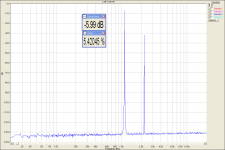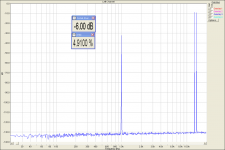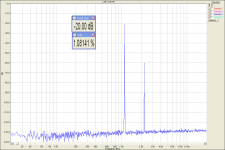I listened using the latest Foobar version on a clean W8.1 install. Draw your own conclusions 😉
Maybe I was just consistently pressing the wrong button (opposite to what I wanted).
Thanks for the result, Karl!
I listened using the latest Foobar version on a clean W8.1 install. Draw your own conclusions 😉
Maybe I was just consistently pressing the wrong button (opposite to what I wanted).
Here's the funny thing about statistics- if you got 7/8 correct, people would say that, yes, you heard a difference. Yet its significance is exactly the same as getting 7/8 wrong. 😀 One more example of the math being non-intuitive.
I only listened casually last night, but didn't hear much, if any, difference.
One more example of the math being non-intuitive.
Just had two more attempts at this and scored a 4/8 and a 5/8. So I guess I can't reliably hear a difference. The weird thing is, I sometimes think I can and that one of the tracks has a slightly more 'granular' sound. My results suggest otherwise though.
The same mechanism must be at work when we evaluate a part or a circuit and we know which we are listening to because we then form definite preferences. Listen to it blind (SY's no peeking rule 😀) and it would be a different story in many cases.
(remember the mega cap test and all those separately produced files. I used an online random number generator to pick the sequence to present the files and one run gave something like A, A, A, A, A, B..... and then a more 'normal' or at least what you might consider more normal sequence emerged, and so yes, what SY mentions really does happen)
Pavel, thanks for this interesting test, but both tracks sound somewhat filthy to me, certainly in the loud passages. It wouldn't be my preferred presentation track for sure.
That being said, both piano and violin have complex overtone structures, so adding a clean H2 distortion will only slightly alter the timbre. With cleaner tones, flute or female voice, it might become much more obvious.
That being said, both piano and violin have complex overtone structures, so adding a clean H2 distortion will only slightly alter the timbre. With cleaner tones, flute or female voice, it might become much more obvious.
Most obvious it is with sine tone 🙂
However, intermodulations on string sound should change something, isn't it? They create dis-harmonic tones, not harmonic tones.
The file is mono, and we are not used to listen to mono files anymore.
However, intermodulations on string sound should change something, isn't it? They create dis-harmonic tones, not harmonic tones.
The file is mono, and we are not used to listen to mono files anymore.
One of the files is distorted, in this way. The corresponding distortion is H2, 10% at full scale.The other file has no distortion added.
No other things added/altered?? What about your previous post regarding transfer function (I didn't get it)...
I had some difficulty (seems Mooly as well) because the "situation" is not natural. It is not what would happen in practice, so very hard to apply experience here. Vacuphile has also mentioned the point.
When I first listened the files, it was obvious to me that one file has higher distortion. But upon long listening, it is not really "fatiguing" as it should. May be what Vac referred to as clean H2. In fact, the distortion made it more present and alive.
But I was thinking about any effort to change the dynamics (compression)... So no dynamic change here?
Pavel, that's what I did, as noted in the previous post - I was then able to hear clear differences, and with the laptop speakers sound found the 4b version better quality, and voted accordingly. Cleaner, timbre of violin was closer to being realistic, better overall listening experience.Frank, try audacity, I think it can convert mono files back to stereo, with same L and R channels.
Assuming that I know what it is I am listening for I would say that B is the original and A has the distortion added.
I think file A sounds slightly more grainy, noticeable at the fade in at the start. In Foobar with standard settings I can't detect a statistical difference. Playing it in media player with a little tweak of the graphic equalizer I feel I can hear a difference. The graininess.
So I'll vote 😉
So I'll vote 😉
04a is the original music file. 04b is 04a that went through transfer function with distortion that I have shown and described in this thread. The poll is over, preferences
04a : 04b
3 : 5
04a : 04b
3 : 5
04a is the original music file. 04b is 04a that went through transfer function with distortion that I have shown and described in this thread.
Interesting! Tho I still don't believe (like I said in PM) that "adding" H2 is the only thing you did to the file. Can you explain about the transfer function? What is the process to add H2?
With cheap system (computer speaker at work) I found that 04a is more distorted. At home I used my speaker. I played 04a after getting home until morning. I expected a fatigue but no fatigue! This was a surprise for me. So I played 04b in the morning and I knew that 04a is more present and alive.
I made assumption that it is probably the effect of H2 without higher order distortion. If so, then I thought I could understand why Scan Speak tweeters now has high H2 but lower higher order distortion. Because H2 didn't do a damage to 04a but improve presence and more alive.
But now I cannot draw that conclusion??
Last edited:
Thanks Pavel. Interesting ! Even knowing you added H2 it didn't sound as I imagined it might sound.
Thanks Pavel. Interesting ! Even knowing you added H2 it didn't sound as I imagined it might sound.
Karl, there are many popular myths in audio, one of them is the "sound of the 2nd harmonic". People usually make their observations from listening of SE tube amplifiers, and they forget there are so many other factors that have an influence to the resulting sound. So it is simply attributed to H2, without any deeper knowledge. Popular reviews support these false claims.
In this case, the nonlinear distortion through ax2 + bx + c transfer function is added. Frequency independent. Level dependent, of course, as per the formula. This is pure 2nd harmonic distortion, in isolation, without other influence.
Karl, there are many popular myths in audio, one of them is the "sound of the 2nd harmonic". People usually make their observations from listening of SE tube amplifiers, and they forget there are so many other factors that have an influence to the resulting sound. So it is simply attributed to H2, without any deeper knowledge. Popular reviews support these false claims..
Conclusion of this short test? That h2 is indeed preferable??
In this case, the nonlinear distortion through ax2 + bx + c transfer function is added. Frequency independent. Level dependent, of course, as per the formula. This is pure 2nd harmonic distortion, in isolation, without other influence.
I still don't get how this thing works. So h2=aXX+bX+c where X is the level? What happen to the resulting level and dynamics?
Surely it is pure 2nd order distortion, which will have equal amounts of 2nd harmonic and 2nd order intermodulation? This is what your plots (post 24) seem to show.PMA said:In this case, the nonlinear distortion through ax2 + bx + c transfer function is added. Frequency independent. Level dependent, of course, as per the formula. This is pure 2nd harmonic distortion, in isolation, without other influence.
- Status
- Not open for further replies.
- Home
- General Interest
- Everything Else
- Subjective listening test


